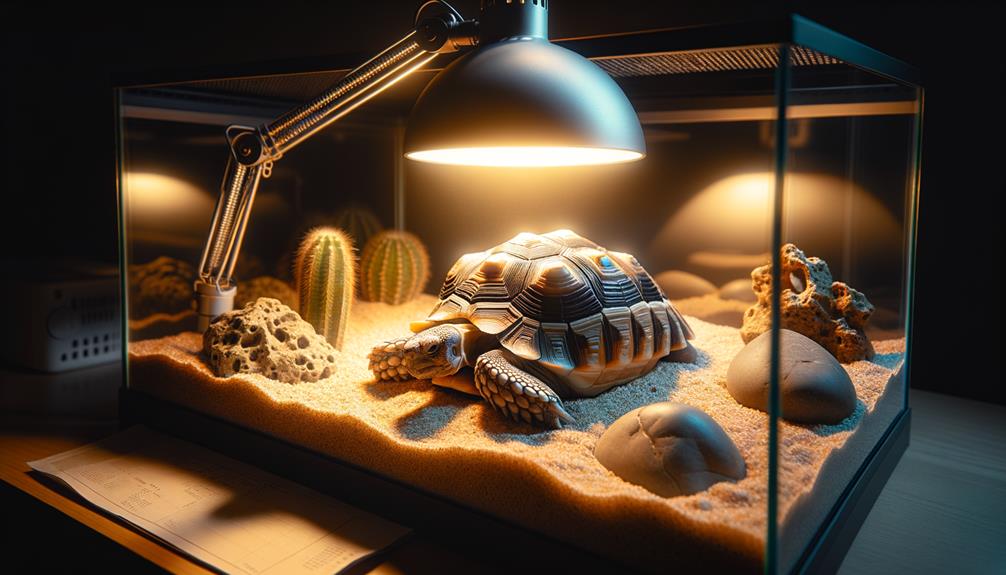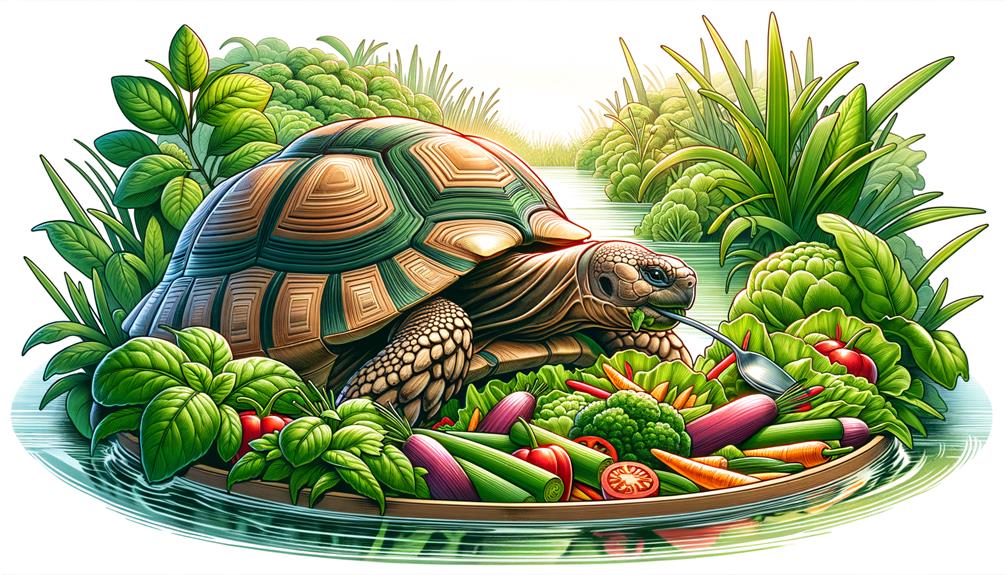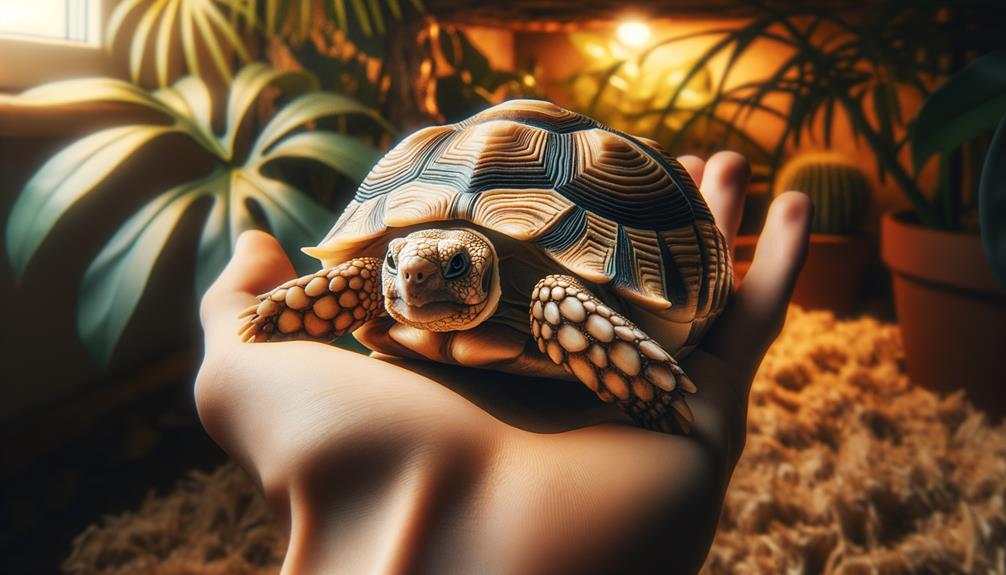Russian tortoises are incredibly resilient creatures. They thrive in rocky desert environments with well-drained substrate to prevent health issues. To keep them happy and healthy, you'll need to provide ideal conditions, including a basking area of 95-100°F, cooler zones of 75-80°F, and a 12-14 hour UVB light cycle. A diet consisting of dark leafy greens, fibrous vegetables, and supplemental calcium and vitamin D3 is essential. Regular vet check-ups and maintaining the best habitat conditions are key to their long lifespan, often over 40 years.
Key Takeaways
Russian tortoises thrive in desert environments with rocky outcrops and well-draining soil. They need a warm basking spot with temperatures between 95-100°F to stay healthy. A diet rich in dark leafy greens and fibrous vegetables provides them with essential nutrients. Exposure to UVB light is vital for calcium metabolism and strong bone development. Regular cleaning and veterinary check-ups help prevent health issues like respiratory infections and parasites.
Habitat and Environment
Creating a suitable habitat for Russian tortoises involves replicating their native rocky desert environment. When setting up an enclosure, I strive to mimic their natural surroundings. This means using a dry, well-drained substrate to prevent shell rot and respiratory issues. I incorporate hide boxes and tunnels for burrowing, as they instinctively dig to regulate their body temperatures.
A proper basking area is crucial, where temperatures should reach 95-100°F. For this, I use flat rocks or slate under direct sunlight. The enclosure should also have cooler areas, around 75-80°F, to allow the tortoise to thermoregulate effectively. Heat sources, like ceramic heat emitters, can help maintain consistent temperatures, especially in cooler climates.
In addition to heat, UVB lighting is vital. It supports calcium metabolism and prevents metabolic bone disease. I ensure their diet is varied and high in fiber, mimicking their natural forage. This means offering a mix of leafy greens, vegetables, and occasional fruits. By focusing on these elements, I create a habitat that promotes their health and natural behaviors.
Temperature and Lighting

When it comes to creating a comfortable environment for your Russian tortoise, temperature and lighting play a crucial role in their overall health. To keep them thriving, you'll want to provide a basking spot with a warm temperature of around 95-100°F. The daytime temperature can be slightly cooler, ranging from 85-88°F, while nighttime temperatures can safely drop to 60-75°F. Additionally, it's vital to provide your tortoise with proper UVB lighting for 12-14 hours daily, as this helps them metabolize calcium and prevents metabolic bone disease.
Ideal Temperature Ranges
Maintaining the right temperature and lighting conditions is crucial for the health and well-being of Russian tortoises. These hardy creatures thrive when their environment mimics natural temperature cycles. During the day, they need a basking spot temperature of 95-100°F to keep their body temperature at an optimal level and support their activity levels. Background temperatures should hover around 85-88°F, dropping to 75-80°F at night. This fluctuation in daytime and nighttime temperatures is vital for their physiological processes.
Using radiant heat panels can help maintain stable temperatures within the enclosure, providing even, thermostatically-controlled heating. Ceramic heat emitters serve as excellent nighttime heat sources without disturbing the tortoises' natural light cycle. Speaking of light, adequate UVB lighting is necessary for calcium metabolism and bone development. Aim for a 12-14 hour daily light cycle using artificial lighting that simulates natural conditions.
| Temperature Range | Purpose |
|---|---|
| 95-100°F | Basking spot temperature |
| 85-88°F | Background daytime temperatures |
| 75-80°F | Nighttime temperatures |
| 12-14 hours daily light | UVB light cycle for calcium metabolism |
Hatchlings and juveniles require even higher basking temperatures and longer photoperiods to ensure proper growth. Keeping these conditions consistent and adapting as needed will ensure your Russian tortoise remains healthy and active.
Effective Lighting Setup
Effective Lighting Setup for Russian Tortoises
Setting up an effective lighting system is crucial for providing Russian tortoises with the necessary UVB exposure and thermal gradients they need to thrive. To achieve this, I place a UVB light that provides 12-14% UVB radiation over the basking area, about 12-16 inches from the tortoise. This setup mimics the natural sunlight they'd get in the wild.
I create a thermal gradient within the enclosure by maintaining a basking spot temperature of 95-100°F and a cooler area around 75-80°F. This range allows the tortoise to regulate its body temperature effectively. For the basking area, mercury vapor bulbs are ideal because they provide both heat and UVB radiation.
To simulate a natural day-night cycle, I ensure there are 12-14 hours of daylight during the summer and 10-12 hours in winter. This lighting schedule discourages hibernation and keeps the tortoise active. Additionally, I supplement the lighting with bright white or LED bulbs to mimic natural sunlight and promote activity.
Closely monitoring temperatures is vital. I adjust the lighting and heating as needed to maintain the ideal thermal gradient within the enclosure. This precise setup ensures my Russian tortoise remains healthy and vibrant.
Diet and Nutrition

A well-balanced diet is vital for the health of Russian tortoises, requiring a mix of dark leafy greens, fibrous vegetables, and occasional fruits, supplemented with calcium and vitamin D3. These tortoises thrive on a variety of leafy greens like collard greens, kale, and dandelion greens, which provide essential vitamins and minerals. Including fibrous vegetables and hay helps maintain their digestive health and mimics their natural diet in the wild.
To prevent metabolic bone disease, a common issue in captive tortoises, especially those housed indoors without adequate natural sunlight, supplementation with calcium and vitamin D3 is necessary. A small amount of fruit, like apples and berries, can be offered occasionally, but it should not dominate their diet, as excessive sugar can lead to health problems.
Although commercially available pelleted tortoise diets are convenient, they often lack the complete nutritional spectrum needed by Russian tortoises. Therefore, it's essential to supplement these pellets with fresh produce to ensure they receive a balanced diet. By providing a varied and nutrient-rich diet, you can help these hardy dwellers live long, healthy, and active lives.
Health and Wellness

Russian tortoises face several common health issues, including respiratory infections, metabolic bone disease, and gastrointestinal parasites. To prevent these problems, it's crucial to provide a balanced diet rich in calcium and ensure proper UVB lighting. Regular veterinary check-ups and maintaining ideal environmental conditions are also essential for keeping your tortoise healthy and thriving.
Common Health Issues
Russian tortoises are resilient, but they can still face several common health issues that owners need to be aware of to ensure their pets thrive. One notable concern is respiratory infections, which can occur if they're kept in cool, damp conditions or fed an improper diet. These infections can cause wheezing or nasal discharge and require prompt veterinary check-ups.
Another issue is metabolic bone disease, which can occur if Russian tortoises don't receive adequate UV lighting and calcium supplementation. This disease weakens their bones, making them prone to fractures. Ensuring they have access to proper UV lighting and a calcium-rich diet is crucial.
Russian tortoises can also carry Salmonella bacteria, posing a risk to human health if proper hygiene practices aren't followed. Washing your hands after handling them can mitigate this risk.
Gastrointestinal parasites are another issue, leading to diarrhea and weight loss. Regular veterinary check-ups and maintaining good hygiene in their habitat can help prevent these problems.
Here's a quick reference table for common health issues:
| Health Issue | Cause | Prevention |
|---|---|---|
| Respiratory infections | Cool, damp conditions, improper diet | Proper habitat setup, balanced diet |
| Metabolic bone disease | Lack of UV lighting, calcium deficiency | Adequate UV lighting, calcium-rich diet |
| Salmonella | Bacteria transmitted through handling | Good hygiene practices |
| Gastrointestinal parasites | Contaminated food or water | Regular vet check-ups, clean habitat |
Dietary Needs
A balanced diet is crucial for your Russian tortoise's overall health. Focus on providing a variety of dark leafy greens, such as kale, collard greens, and dandelion greens, which are rich in fiber and essential nutrients. These greens promote healthy digestion and support overall well-being.
In addition to greens, calcium and vitamin D3 supplements are vital, especially for indoor tortoises that don't receive natural sunlight. These supplements help prevent metabolic bone disease by supporting proper calcium metabolism. You can also offer a mix of lettuces and grasses to diversify their diet and ensure they receive a balanced intake of essential nutrients.
Fresh fruits can be a nutritious treat in moderation, but they should not be a staple due to their high sugar content. While commercial pelleted diets can be part of their nutrition, it's not recommended to rely solely on them, as they often lack necessary fiber and nutrients.
Proper hydration is also essential. Always provide a shallow water dish, and consider occasional misting to ensure your tortoise stays hydrated. This practice supports their overall health and aids in digestion.
Handling and Interaction

Here's a rewritten version of the text, following the given instructions:
Handling and Interaction
To ensure your Russian tortoise feels comfortable and secure, it's essential to approach it calmly and let it walk onto your hand. Russian tortoises are generally calm and gentle creatures, but improper handling can cause them significant stress. Handling your tortoise correctly is vital to maintain its well-being and build a trusting relationship.
When interacting with your tortoise, keep the following guidelines in mind:
- Slow Approach: Move slowly and let the tortoise approach your hand. This reduces stress and makes the interaction more comfortable for them.
- Proper Lifting: Never grab the tortoise by its shell, legs, or tail. Instead, gently scoop it up with both hands, supporting its entire body.
- Supervise Children: Always supervise young children during interactions to ensure they handle the tortoise gently and appropriately.
- Gradual Acclimation: Introduce handling gradually. Start with short sessions and increase the duration as the tortoise becomes more accustomed to human contact.
This rewritten text aims to be more conversational and natural, avoiding AI digital thumbprints and the list of words to avoid.
Lifespan and Growth

Many Russian tortoises can live well over 40 years in captivity when they receive proper care. From the moment they hatch, these resilient creatures have the potential to grow from just one inch to 8-10 inches as adults. Females tend to surpass males in size, reaching the maximum dimensions.
Captive-bred babies, nurtured in controlled environments, often enjoy a higher life expectancy compared to their wild-caught counterparts. This is largely due to a high-fiber diet and low-stress settings, which are essential aspects of Russian tortoise care. Ideal living conditions, including maintaining higher humidity levels and providing a spacious habitat, contribute significantly to their lifespan.
| Stage | Size (inches) | Lifespan (years) |
|---|---|---|
| Hatchling | 1 | – |
| Young Russian | 3-5 | – |
| Adult Tortoise | 8-10 | 40+ |
Russian tortoises thrive when provided with a detailed care sheet and precise environmental controls. Among tortoise species, the Russian tortoise stands out for its hardy nature and manageable care requirements. By providing a stress-free environment and ensuring they have a balanced, fibrous diet, you can help your Russian tortoise enjoy a long and healthy life, making them a fulfilling companion.
Frequently Asked Questions
How Hardy Are Russian Tortoises?
I've found Russian tortoises to be incredibly resilient creatures. They can adapt to extreme temperatures, survive harsh winters through hibernation, and live for over 40 years with proper care. Their compact size and natural resistance to disease make them an ideal choice for reptile enthusiasts.
How Cold Is Too Cold for a Russian Tortoise Outside?
Russian tortoises can handle temperatures as low as 50°F (10°C), but anything below 40°F (4°C) can be life-threatening. It's essential to keep an eye on the weather when letting them roam outside.
Can Russian Tortoises Survive Winter?
Russian tortoises can survive winter by hibernating. To prepare mine, I ensure it has a well-insulated and well-drained retreat, and I gradually reduce its temperature and food intake. If it gets too cold, I bring it indoors, mimicking natural conditions.
What Is the Most Hardy Tortoise?
I believe the Russian tortoise is exceptionally resilient. Its ability to adapt to extreme temperatures and thrive in various environments makes it incredibly durable. With proper care, it flourishes both indoors and outdoors, ensuring a long and healthy life.



